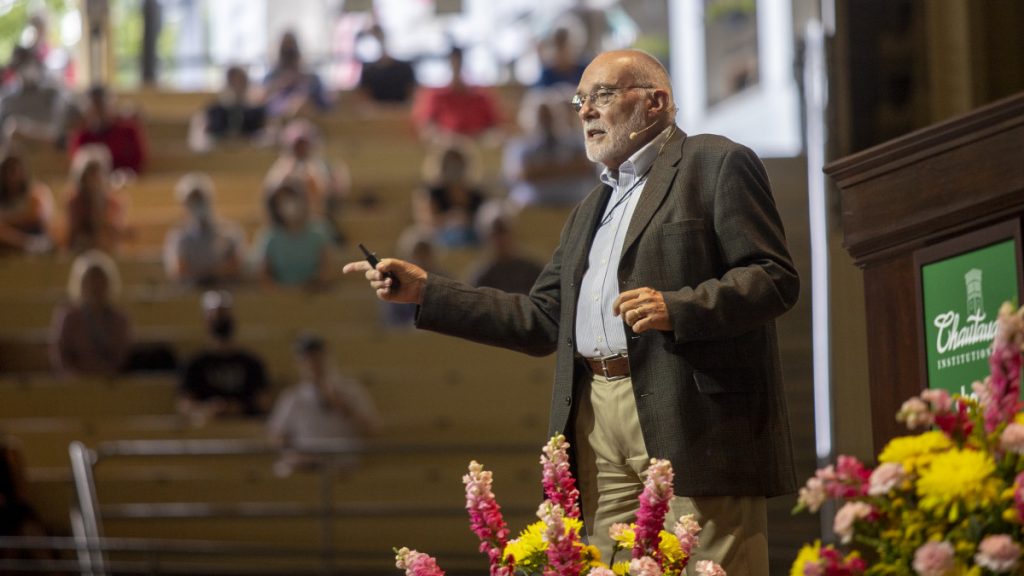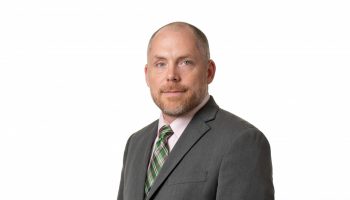Photos of cacti with a backdrop of a brilliant blue, a starry sky contrasted against aerial photos of nighttime Chicago sliced into a grid by streetlights — these are some of the images displayed by National Geographic photographer Jim Richardson on Monday, Aug. 1 to the Amphitheater audience at the first 10:45 a.m. lecture of Week Six “After Dark: The World of Nighttime.”
His lecture, titled “Vanishing Night,” focused on light pollution and the Milky Way. Richardson opened his discussion with the places and projects his job as a photographer has led him to.
In order to demonstrate his approach to photography, Richardson showed a photo of soil erosion on the Shaanxi Plateau in China. While the photo had little to do with the decreasing visibility of the Milky Way, it helped demonstrate his overall point.
Richardson photographed the Shaanxi Plateau because it has some of the worst soil erosion in the world, but when he asked the farmers working on their field, they said they did not have a problem with soil erosion.
“It’s crept up on them. It’s not that they can’t see it, but that they don’t know what they are seeing,” Richardson said.
He believes this is where a photographer can shed light.

“I’m in the seeing business, but I’m also in the knowing business,” he said.
A combination of facts and images drove Richardson’s lecture. While he admitted he is not a scientist, he has a bit of expertise on the disappearing night sky because he spent time photographing the subject for National Geographic.
Camera technology is at a point where photographers can showcase light pollution and the night sky, he said. So, with NatGeo, Richardson went to the Natural Bridges National Monument in Utah. This location was chosen for a specific reason.
“It was the first of the dark sky parks in the world. And it really is magnificent,” he said. “There is a scale for this stuff, the Bortle scale.”
The Bortle scale in one of the darkest skies in the world will show “such darkness that the Milky Way will cast a visible shadow.”
With the help of a park ranger to light up the underside of a natural rock bridge, Richardson took his first series of dark sky photos, capturing the brownish red rock bridge against the night sky speckled with white.
The photo taken there became the lead picture of the NatGeo cover story, “Our Vanishing Night,” which was published in November 2008.
“I was convinced that what we first had to understand was not the problem, but the loss of the splendor; the loss of the night sky; the loss of what has been, throughout our humanity, this wonderful heritage, this constant companion, this wonderful, wonderful place — our galaxy — and we live out there,” he said.
Richardson shared that when it is truly dark out and the Milky Way is visible, looking at the southern end of the galaxy, toward the center, is where the black hole of our galaxy is.
“That big super massive black hole that drives all of this, that emits these gravity waves that cause the crest of the waves of star formation — it’s a marvelous process, and we are not just inhabitants of it,” he said. “We’re part of that process. It’s an incredible thing.”
Richardson then shifted the audience’s focus to how the Earth looks from space, with bright splatters of light pollution across the globe, specifically in areas like the Eastern United States, Western Europe and India.
He explained that this radical shift in how our world looks from space has occurred in just over 140 years since Thomas Edison invented the lightbulb. This portion of time is relatively small, and these changes happened quite rapidly.
“To a large degree, it’s a population map, isn’t it?” Richardson asked. “Except, conspicuously, from Africa. Because, not only is it a map of population, it’s a map of GDP — gross domestic product. Curiously, it’s also a map of paved roads. You have more light pollution where you have more paved roads.”
During Richardson’s photographic journey for this night sky project, he traveled to Burkina Faso in West Africa. There, he photographed people around a campfire with the vibrant night sky above them.
“For much of our existence here on planet Earth, this was our world. This was our world, you know? Sitting around the fire at night, the stories going back and forth, stories being projected onto the planets, stories being projected onto the constellations,” he said. “(The sky was) our constant partner, part of our heritage, how we think, how we react, how we commune with our families and our clans and all of that — that wonder that we feel when we sit there and look up at a pristine, beautiful night sky and contemplate the universe.”
He accompanied this with a photo of a man in Tanzania sitting on the ground and gazing up at the sky.
Richardson said people were created from stars, and if light pollution causes the connection to be lost between people and the night sky, the connection to our beginning is also lost.
“All the atoms in our bodies formed within the hearts of stars,” he said. “It’s the only place you can make complex atoms. So, we are not just the observers. We are the participants in this great journey. And I think it’s worthwhile for us to consider with our knowledge, with what we know, how we think about the night.”
Richardson said that of the children born today, 80% will never see the Milky Way.
Light pollution is particularly rampant in cities, he explained, showing pictures of Central Park in New York City lit up at night, as well as photos of Denver and Chicago — the latter of which became the cover of the National Geographic issue that featured Richardson’s photos of the disappearing night sky.
In some places, the lights are so bright at night that they have earned the term “sky glow.” When Richardson photographed the Gateway Arch in St. Louis, the lights shining up at the arch were so bright they cast a shadow from the arch onto the clouds overhead.
Cities are not the only places that have a light pollution problem, Richardson pointed out, pulling up photos of Liberal, Kansas, which has a population of less than 20,000.
“You get this sense of light trespass,” he said.
Richardson addressed the question of light pollution’s definition and effect by listing the tangible issues of light pollution. To begin, he said, it disrupts the circadian rhythms of humans, suppresses the production of melatonin, and has even been found to cause breast cancer.
His example of this was his photo of a taxi’s rearview mirror, showing the reflection of the tired eyes of a man.
“It looks pretty much like that,” Richardson said. “Harder to see. Harder for me to photograph, but that one kind of got to it.”
The impacts on nature are also significant. He gave examples of how migratory patterns of birds, the eating patterns of bats, and firefly mating are disrupted because of light pollution.
Tall buildings with bright lights frequently cause birds to fly into them and, subsequently, die. Toronto resident, Brian Armstrong, noticed an injured bird and now patrols the streets of Toronto to try to save the birds that have mistakenly flown into the buildings.
The birds he can’t save, he collects for the Fatal Light Awareness Program, which creates a display of all the birds that died flying into buildings.
“It was one of the most profoundly affecting things I saw,” Richardson said. “All these birds, lying out there.”
Light pollution also leads to the death of the loggerhead turtles, which frequently breed in Juno Beach, Florida. The endangered turtles return to within 100 yards of where they were born to lay their own eggs.
“Often they come back to nest, to find that somebody has built a new house or a new high-rise tower that’s all lit up,” Richardson said.
This is not where the disruption ends. Once the loggerhead eggs hatch, Richardson explained, they are confused by the lights and head toward them rather than toward the ocean where they can swim away. When they move to the light, they often find themselves on highways where they could be run over by cars.
Even with all of the effects on nature, Richardson believes the light pollution problem is not unsolvable.
“There’s one big cure: Turn the lights down,” he said. “We can do all the technological things we want. But essentially, we have to figure out a way to live with the lights turned down a little bit.”
To experience a town where all the lights were truly turned off, Richardson returned home to Cuba, Kansas. On the Amp’s screens, he contrasted two photos: the first with the streetlights on and the second with all the lights off. The difference was not only visible in the sky, but in all the people gazing up at the stars.
Richardson also gave the example of Harmony, Florida, which is part of the International Dark Sky Association.
“They use these lamp shades in which no light goes up, and light goes down where you want it — where you’re walking at night,” he said. “But, you notice the houses back there? It’s not even lighting up the tops of the houses. So, light where you want it.”
Another photo Richardson took in Harmony has herons in the foreground and large homes in the background.
“What it means is the sandhill cranes can coexist with very nice housing,” he said. “That’s an impressive thing to me, that it’s not necessarily an either/or kind of situation.”
The International Dark Sky Association has also worked to create 195 dark sky parks, Richardson shared, from New Zealand to the United Kingdom, and even with many in the United States.
He finished his lecture with a call to action.
“I’ll also implore you that when the next zoning commission comes up in your town, when people are discussing street lighting or new developments or anything like this, you go,” Richardson said. “You go and raise your voice at some level to make intelligent decisions about how we can live morally in a world of limits and be happy doing it.”




